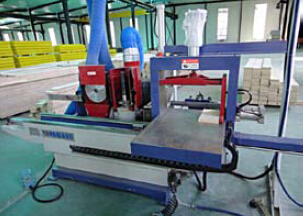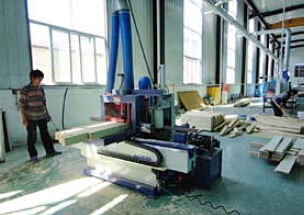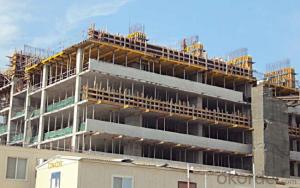Timber-Beam Formwork H20 for formwork and scaffolding system
- Loading Port:
- Tianjin
- Payment Terms:
- TT OR LC
- Min Order Qty:
- 50 m²
- Supply Capability:
- 1000 m²/month
OKorder Service Pledge
Quality Product, Order Online Tracking, Timely Delivery
OKorder Financial Service
Credit Rating, Credit Services, Credit Purchasing
You Might Also Like
Characteristics:
◆ Standardized production lines.
Supply capability: 3000m/day, Lmax = 6600mm.
◆ Finger jointing of the flange and web, the strength of timber beam is highly improved.
Max. shearing force failure load:40KN
◆ Well treated to prevent from water penetration or erosion, so the service life maximally
extended.
Normally, CNBM timber beam H20 can be used for 4 to 5 years, the exact using time would
depend on maintenance & storage.
◆ Robust caps at the end of the girders protect against damages.




- Q:Can steel formwork be used in areas with limited construction access roads?
- Yes, steel formwork can be used in areas with limited construction access roads. Unlike traditional formwork made of wood or other materials, steel formwork is durable, lightweight, and can be easily transported to remote locations. It can be disassembled and reassembled multiple times, making it suitable for areas with limited access roads where transportation of heavy construction materials is challenging. Additionally, steel formwork offers high strength and stability, ensuring the structural integrity of the construction even in difficult-to-reach areas.
- Q:How does steel formwork affect the overall sustainability of a concrete structure?
- Steel formwork can have a positive impact on the overall sustainability of a concrete structure. Firstly, steel formwork is durable and reusable, reducing the need for new materials and minimizing construction waste. Secondly, its strength and stability contribute to the structural integrity and longevity of the concrete structure. Additionally, steel formwork allows for efficient and precise construction, reducing the amount of concrete required and minimizing energy consumption. Overall, the use of steel formwork enhances the sustainability of concrete structures by reducing environmental impact and promoting long-term durability.
- Q:How does steel formwork affect the overall energy efficiency of the structure?
- The overall energy efficiency of a structure can be significantly influenced by steel formwork. One of the main advantages of utilizing steel formwork is its capacity to deliver a high degree of thermal insulation. Steel possesses a low thermal conductivity, which means it does not easily transfer heat. This characteristic aids in minimizing heat loss or gain through the walls, floors, and ceilings of the structure. The use of steel formwork allows for improved sealing of the building envelope, which reduces air infiltration and enhances the overall airtightness of the structure. This prevents undesired air leakage, which can result in energy loss and decreased energy efficiency. Steel formwork also enables better control of moisture and humidity levels, which is crucial for maintaining a comfortable indoor environment and preventing mold or moisture-related problems. Moreover, steel formwork offers a durable and long-lasting construction solution. It can withstand extreme weather conditions, seismic activities, and other external forces, guaranteeing the structural integrity of the building for many years. This durability reduces the need for frequent repairs or replacements, leading to energy and resource savings in the long run. Additionally, steel formwork is a sustainable choice as it is frequently made from recycled materials and can be recycled at the end of its lifespan. The utilization of recycled steel diminishes the carbon footprint associated with construction and aids in the conservation of natural resources. The recyclability of steel formwork also means that it can be repurposed or reused in future projects, further reducing waste and environmental impact. In conclusion, steel formwork positively impacts the overall energy efficiency of a structure through its excellent thermal insulation, enhanced airtightness, moisture control, durability, and sustainability. By selecting steel formwork, builders can create energy-efficient buildings that are environmentally friendly and cost-effective in the long term.
- Q:What are the common challenges when using steel formwork?
- Some common challenges when using steel formwork include its heavy weight, which can make transportation and handling difficult, the need for specialized equipment and skilled labor for installation and removal, the potential for corrosion if not properly maintained, and the higher initial cost compared to other formwork materials.
- Q:How does steel formwork contribute to the overall sustainability of the construction industry?
- Steel formwork contributes to the overall sustainability of the construction industry in several ways. Firstly, steel formwork is highly durable and long-lasting. It can be reused multiple times, reducing the need for new formwork materials for each construction project. This significantly reduces the amount of waste generated during the construction process and minimizes the overall environmental impact of the industry. Additionally, steel formwork is a more sustainable alternative to traditional formwork materials such as timber. Timber formwork often requires cutting down trees, which contributes to deforestation and habitat destruction. By utilizing steel formwork, we can reduce our reliance on timber and help preserve forests. Steel formwork also offers greater structural stability and strength compared to other materials. This allows for more efficient construction processes and reduces the need for additional support structures. As a result, less material is wasted, energy is saved, and the overall construction time is shortened, making the process more sustainable. Furthermore, steel formwork is highly resistant to weather conditions, corrosion, and fire. This ensures the longevity of the buildings, reducing the need for frequent repairs or replacements. By using steel formwork, we can create structures that have a longer lifespan, resulting in reduced resource consumption and waste generation over time. Lastly, steel formwork is recyclable. At the end of its life cycle, steel formwork can be easily melted down and reused for other applications. This reduces the demand for new steel production, conserving natural resources and reducing energy consumption. In conclusion, steel formwork contributes to the overall sustainability of the construction industry by being durable, reusable, resistant to weather conditions, and recyclable. Its use helps minimize waste generation, deforestation, energy consumption, and resource depletion, making it an environmentally-friendly choice for construction projects.
- Q:What are the different safety precautions to be followed during steel formwork installation?
- During steel formwork installation, there are several safety precautions that must be followed to ensure the well-being of workers and the overall success of the project. These precautions include: 1. Proper training and supervision: All workers involved in the installation process should be properly trained in handling steel formwork and its components. They should also receive adequate supervision to ensure they are following safety guidelines. 2. Personal protective equipment (PPE): Workers should be provided with and required to wear the appropriate PPE, including hard hats, safety goggles, gloves, and steel-toed boots. This will protect them from potential hazards such as falling objects or sharp edges. 3. Secure footing: It is essential to ensure a stable and secure footing for workers during formwork installation. This can be achieved by clearing debris, maintaining a clean and organized work area, and providing stable platforms or scaffolding. 4. Fall protection: Fall protection measures should be implemented, especially when working at heights. This may include installing guardrails, safety nets, or personal fall arrest systems. Workers should also be trained on how to properly use these systems and equipment. 5. Proper lifting techniques: The use of heavy steel formwork components requires proper lifting techniques to prevent strains, sprains, or other injuries. Workers should be trained on the correct lifting methods, such as bending at the knees and using their leg muscles rather than their back. 6. Equipment inspection: Regular inspection of all equipment, including cranes, hoists, and lifting devices, should be conducted to ensure they are in proper working order. Any defective equipment should be immediately repaired or replaced. 7. Communication and coordination: Effective communication and coordination among workers are crucial to maintaining a safe working environment. This includes clear instructions, proper signage, and regular safety meetings to address any concerns or potential hazards. 8. Fire safety: Steel formwork installation may involve the use of welding or cutting equipment, which presents a fire hazard. Adequate fire prevention measures, such as fire extinguishers and fire-resistant barriers, should be in place, and workers should be trained on proper fire safety protocols. 9. Emergency response plans: It is important to have well-defined emergency response plans in place, including procedures for evacuations, first aid, and contacting emergency services. All workers should be familiar with these plans and know their roles and responsibilities in case of an emergency. By following these safety precautions, the risks associated with steel formwork installation can be minimized, ensuring the well-being and safety of workers and the successful completion of the project.
- Q:What are the typical sheet thicknesses used in steel formwork panels?
- The typical sheet thicknesses used in steel formwork panels vary depending on the specific application and requirements, but they commonly range from 2mm to 6mm.
- Q:How does steel formwork affect the overall constructability of a structure?
- The overall constructability of a structure can be significantly impacted by steel formwork. One of the main benefits of using steel formwork is its durability and strength. Steel is renowned for its high load-bearing capacity, enabling it to withstand the pressure exerted by fresh concrete during pouring and curing. This durability guarantees that the formwork remains stable and intact, minimizing the risk of collapse or deformation during construction. Another advantage of steel formwork is its reusability. Unlike traditional formwork materials like timber, steel can be utilized multiple times without compromising its structural integrity. This not only saves costs associated with purchasing new formwork for every construction project but also reduces waste and promotes sustainability. Steel formwork also provides flexibility and versatility in terms of design and construction requirements. It can be easily fabricated into various shapes and sizes, enabling the construction of intricate structures with detailed architectural elements. Steel formwork can be customized to suit specific project needs, facilitating efficient and precise construction. Furthermore, steel formwork delivers a smooth and uniform finish to the concrete surface. This eliminates the need for additional finishing work, such as plastering or sanding, thereby reducing construction time and costs. The smooth finish also enhances the aesthetic appeal of the structure, making it suitable for architectural projects where visual appeal is crucial. Moreover, steel formwork is recognized for its excellent dimensional stability. It resists warping, shrinking, or expanding due to moisture or temperature changes, ensuring accurate and consistent dimensions throughout the construction process. This dimensional stability contributes to the overall quality and precision of the structure. In conclusion, steel formwork has a positive impact on the overall constructability of a structure by offering durability, reusability, flexibility, a smooth finish, and dimensional stability. These advantages not only enhance construction efficiency and speed but also guarantee the structural integrity and aesthetic appeal of the final product.
- Q:What is the expected lifespan of steel formwork ties?
- The expected lifespan of steel formwork ties can vary depending on various factors such as the quality of the steel used, the conditions in which they are used, and the maintenance and care provided. However, on average, steel formwork ties can last for several years, typically ranging from 5 to 10 years or even longer if properly maintained.
- Q:How does steel formwork affect the overall construction cost?
- Steel formwork can have a significant impact on the overall construction cost. While it may have a higher upfront cost compared to other formwork materials like timber or plywood, steel formwork offers durability and reusability, resulting in reduced material and labor expenses for future projects. Additionally, its strength and stability allow for faster construction cycles, reducing labor costs and improving overall efficiency. So, although the initial investment may be higher, the long-term benefits and cost savings associated with steel formwork make it a cost-effective choice for construction projects.
1. Manufacturer Overview |
|
|---|---|
| Location | |
| Year Established | |
| Annual Output Value | |
| Main Markets | |
| Company Certifications | |
2. Manufacturer Certificates |
|
|---|---|
| a) Certification Name | |
| Range | |
| Reference | |
| Validity Period | |
3. Manufacturer Capability |
|
|---|---|
| a)Trade Capacity | |
| Nearest Port | |
| Export Percentage | |
| No.of Employees in Trade Department | |
| Language Spoken: | |
| b)Factory Information | |
| Factory Size: | |
| No. of Production Lines | |
| Contract Manufacturing | |
| Product Price Range | |
Send your message to us
Timber-Beam Formwork H20 for formwork and scaffolding system
- Loading Port:
- Tianjin
- Payment Terms:
- TT OR LC
- Min Order Qty:
- 50 m²
- Supply Capability:
- 1000 m²/month
OKorder Service Pledge
Quality Product, Order Online Tracking, Timely Delivery
OKorder Financial Service
Credit Rating, Credit Services, Credit Purchasing
Similar products
New products
Hot products
Related keywords
























